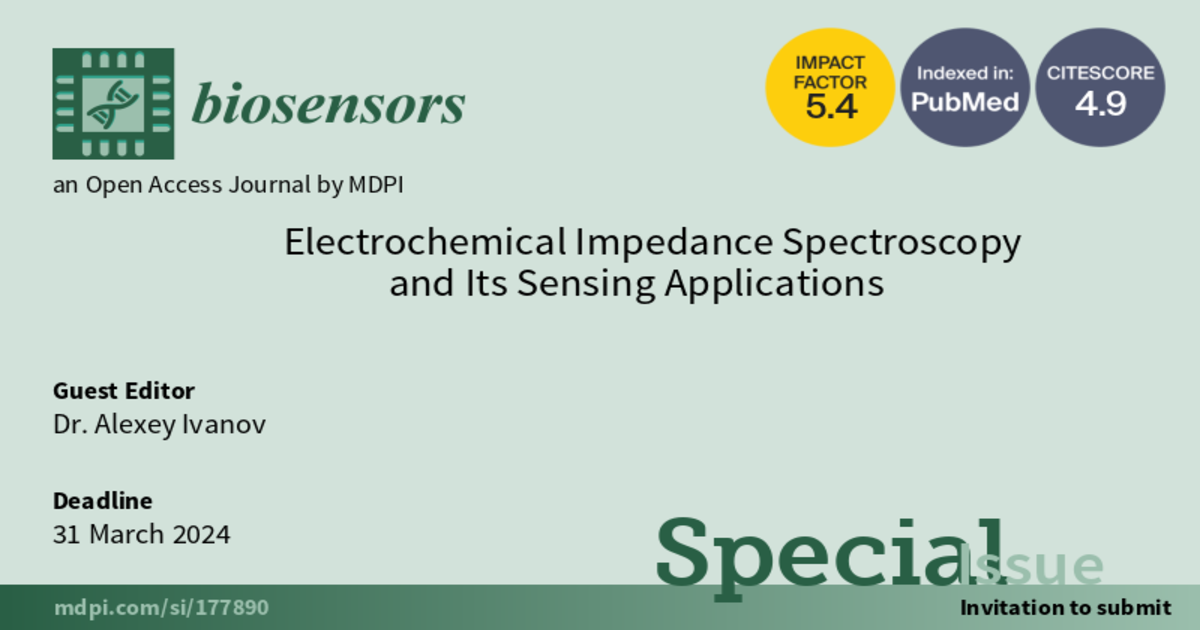Electrochemical Impedance Spectroscopy and Its Sensing Applications
A special issue of Biosensors (ISSN 2079-6374). This special issue belongs to the section "Biosensor and Bioelectronic Devices".
Deadline for manuscript submissions: closed (31 March 2024) | Viewed by 485

Special Issue Editor
Interests: electrochemical sensors; biosensors; DNA sensors; electropolymerization; chemical modification of electrodes; SPR sensors; statistical methods in analytical chemistry; data analysis
Special Issues, Collections and Topics in MDPI journals
Special Issue Information
Dear Colleagues,
Electrochemical impedance spectroscopy (EIS) is a powerful technique that has been widely used in many fields of physics, chemistry, biotechnology and materials science. Furthermore, EIS is considered an important tool for optimizing component performance and studying materials and interfaces. It is a non-invasive technique that does not require complex or expensive instruments and is easy to perform. As a result, it can now be used not only in research laboratories, but also as a tool for controlling processes in battery, semiconductor or thin-film technology. In addition, EIS is increasingly successful in the design and development of sensor systems.
This Special Issue is dedicated to presenting new and interesting research advances related to electrochemical impedance spectroscopy and its application in the field of sensing. This Special Issue will include extended papers from the 12th International Symposium on Electrochemical Impedance Spectroscopy (EIS 2023), but we also strongly encourage researchers who are unable to participate in the conference to submit articles for this call. Authors of selected high-quality papers from the conference are welcome to submit extended versions of their original papers (50% extensions of the contents of the conference paper) and other contributions.
This Special Issue is related to Special Issue "Electrochemical Impedance Spectroscopy for Sensing and Structural and Functional Analysis" in Chmosensors.
Dr. Alexey Ivanov
Guest Editor
Manuscript Submission Information
Manuscripts should be submitted online at www.mdpi.com by registering and logging in to this website. Once you are registered, click here to go to the submission form. Manuscripts can be submitted until the deadline. All submissions that pass pre-check are peer-reviewed. Accepted papers will be published continuously in the journal (as soon as accepted) and will be listed together on the special issue website. Research articles, review articles as well as short communications are invited. For planned papers, a title and short abstract (about 100 words) can be sent to the Editorial Office for announcement on this website.
Submitted manuscripts should not have been published previously, nor be under consideration for publication elsewhere (except conference proceedings papers). All manuscripts are thoroughly refereed through a single-blind peer-review process. A guide for authors and other relevant information for submission of manuscripts is available on the Instructions for Authors page. Biosensors is an international peer-reviewed open access monthly journal published by MDPI.
Please visit the Instructions for Authors page before submitting a manuscript. The Article Processing Charge (APC) for publication in this open access journal is 2700 CHF (Swiss Francs). Submitted papers should be well formatted and use good English. Authors may use MDPI's English editing service prior to publication or during author revisions.






